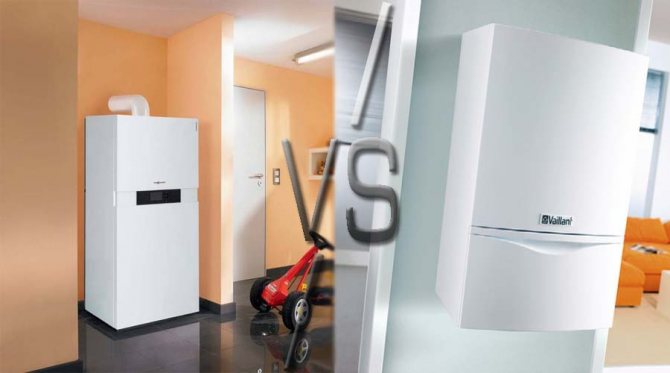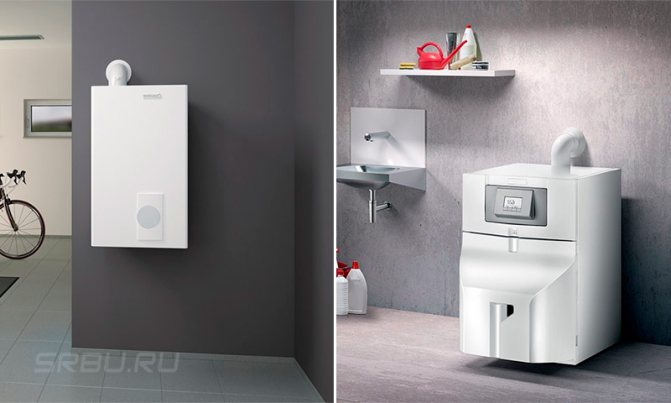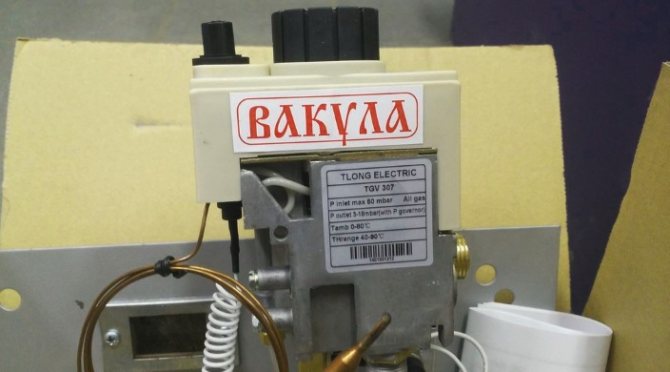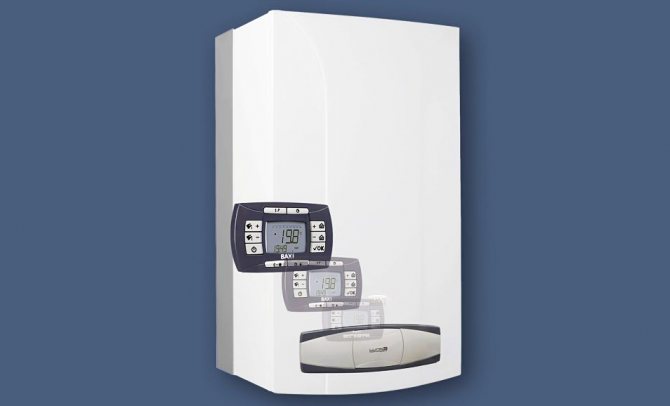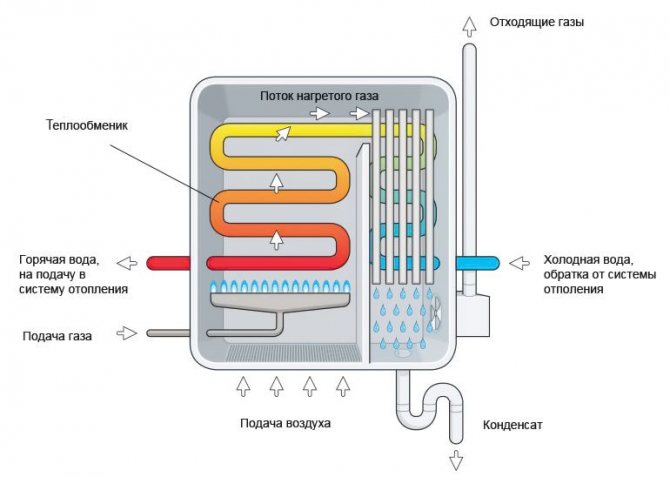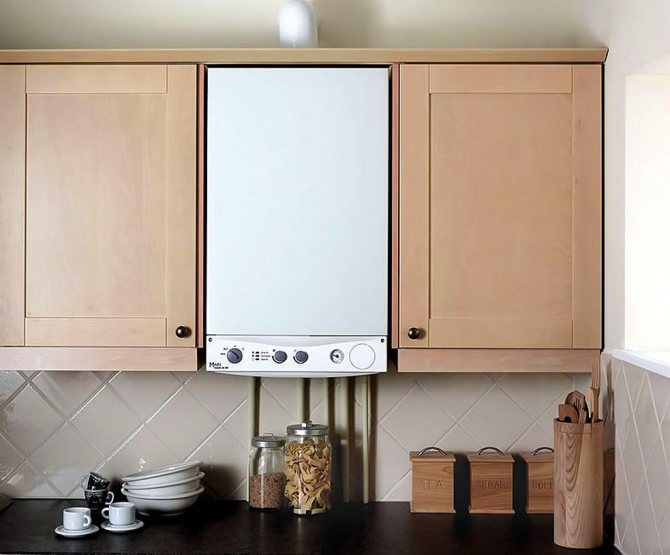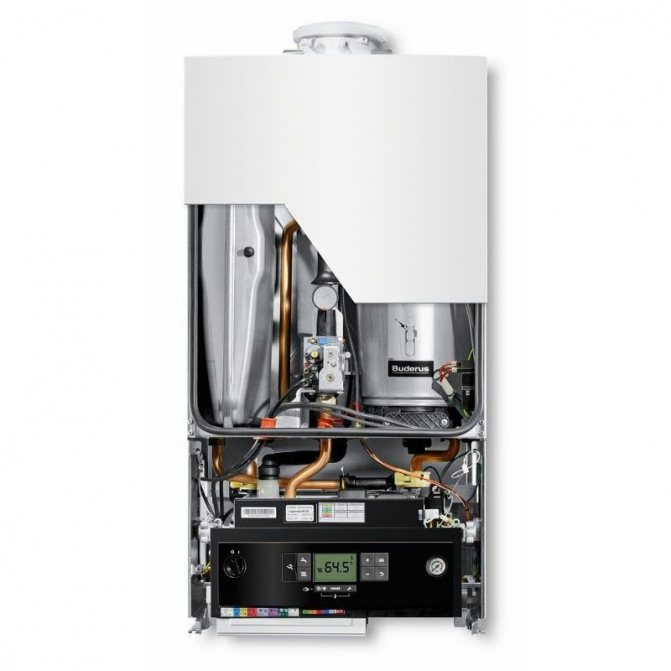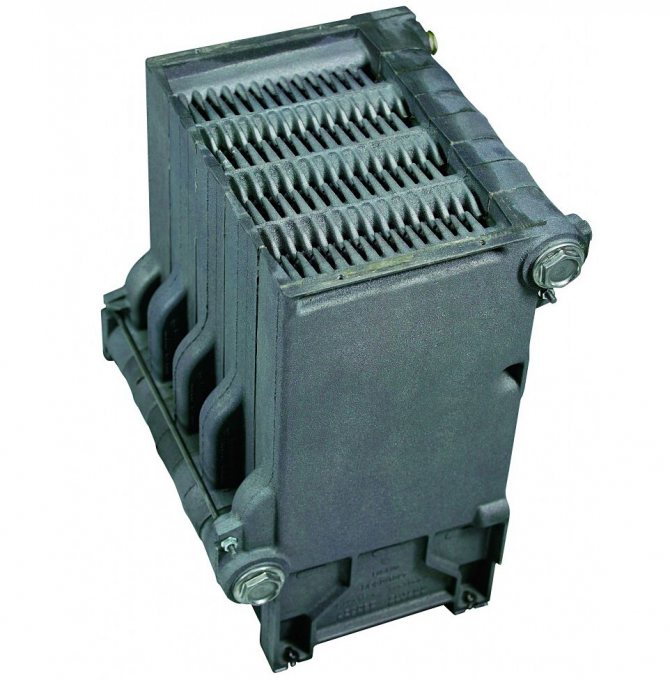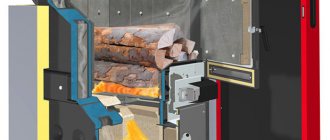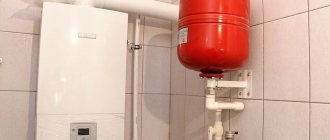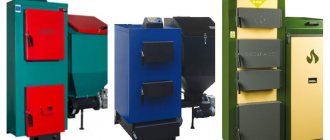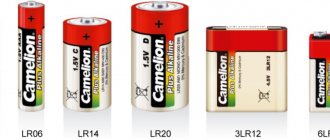Floor-standing and wall-mounted boilers are much more different from each other than it seems at first glance. The first option is traditionally bulky, fairly easy to operate and a high-quality unit, while wall-mounted options are the most efficient, small-sized and multifunctional mini-boiler houses. To make your choice, which boiler is better, you will need to take into account all operational factors.
Dimensions and weight
Dimensions are one of the most important differences between wall and floor gas boilers. The dimensions and weight of wall models are much more modest, otherwise it would be simply impossible to fix them on the wall without the risk of collapse. The lightness of the design is achieved not only by the general compactness of the wall models, but also by the material from which the heat exchanger is made.
For wall-mounted models, the heat exchanger is made only of steel, floor-standing models can have heat exchangers made of cast iron, which has a significantly greater weight, or of steel.
Wall-mounted boilers are often called mini-boilers. And this is no coincidence, because in a relatively small-sized case, not only the burner, heat exchanger and control system components are located, but the circulation pump, expansion tank and other elements, without which the operation of a conventional boiler room cannot do. The compactness of the wall-mounted boiler is its main and indisputable advantage. For such a device, you do not need to allocate a separate room, because you can place it anywhere, for example, in the kitchen.
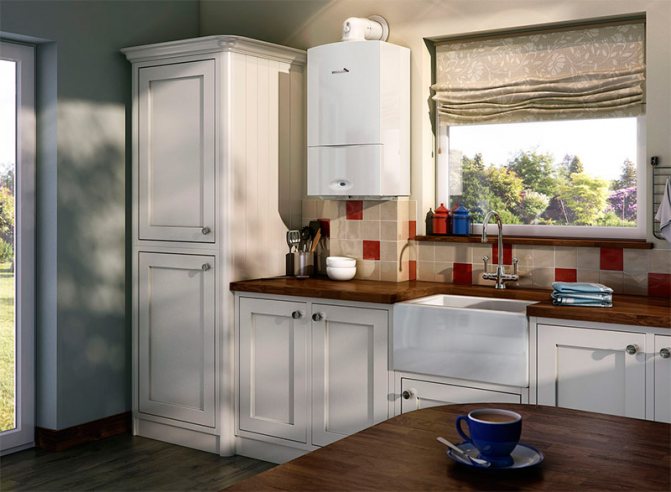
Wall mounted gas boiler with coaxial chimney located in the kitchen area.
The floor-standing models inspire confidence with their dimensions. This is exactly what a powerful boiler should be, providing the ability to heat a large building. However, the dimensions of floor-standing boilers often turn into a problem for their owners. Sometimes, in order to bring such a "giant" into the room, you have to dismantle the doorways. There were cases when, due to the impossibility of bringing the equipment into the boiler room, the purchased floor-standing gas boiler had to be replaced with two lower power ones.
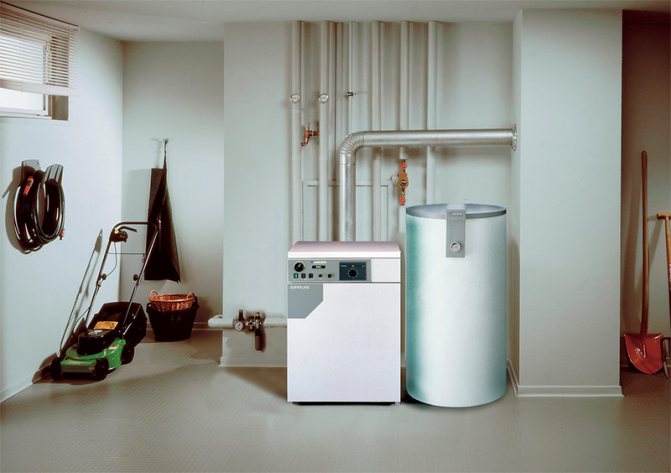

Floor standing gas boiler and indirect heating boiler.
Differences between floor and wall gas boilers
The difference between these modifications of boilers is contained in their internal arrangement and equipment. The principles of heat production are similar for them. Wall-mounted options are very well equipped: a safety and regulation automation unit with primary sensors for monitoring technological parameters, a circulating electric pump, an expansion tank, to protect the structure from overpressure when the medium is heated and other equipment necessary for functioning.
Floor-standing equipment is equipped with a powerful cast-iron heat exchanger, which has the longest operating life of all existing analogues. Auxiliary equipment: pumps, smoke exhausters, fans, mud collectors are completed according to the external installation option. Often, an additional tank with indirect water heating is purchased for these boilers.
Advantages and disadvantages of wall-mounted and floor-standing boilers
Like all modern heat and power equipment, both types of boilers have their own advantages that the buyer should know before deciding which boiler is better.
The advantages of wall modifications include:
- Small size, low weight, the ability to harmoniously fit into the interior of even the smallest room;
- the widest range of functionality and thermal performance;
- operational reliability, stability of work;
- ease of regulation;
- low consumption of gas fuel;
- practicality, availability of maintenance and repair work.
The disadvantages of wall-mounted units can be considered the limited upper limit of their power due to the requirement to reduce the load on the load-bearing walls, as well as the need to use specialized equipment when setting up the boiler.
Floor-standing ones have been used for a long time, so they are structurally more perfect.
The advantages of floor-standing boilers include:
- Highest thermal power, the ability to heat objects of impressive size;
- strength, endurance to operational loads;
- the ability to combine various models into a complex of high performance;
- unlimited range of types with different design qualities and performance;
- ease of installation;
- workflow management is understandable and accessible to every customer.
The disadvantage of this design of boiler units is the need to equip a separate furnace room with glazing and locking doors.
Equipment
In the factory configuration of a wall-mounted gas boiler, as a rule, there is not only the heating device itself, but also a circulation pump, an expansion tank, control system elements, all the necessary sensors and valves. Moreover, all this is hidden in the body of the boiler itself.
By purchasing a wall-mounted gas boiler, you get a miniature boiler room for your use, that is, the minimum set that, after connecting to the heating system, is able to start full-fledged work to heat your home.
Of course, if you wish, you can additionally buy all kinds of room thermostats and regulators, outdoor temperature sensors, a GSM communication module and much more, improving the heating system of your home and increasing the comfort of its control.
A floor standing boiler is usually just a boiler. Circulation pumps, expansion tank and many other related equipment are not included in the delivery set - you will have to buy everything you need separately.
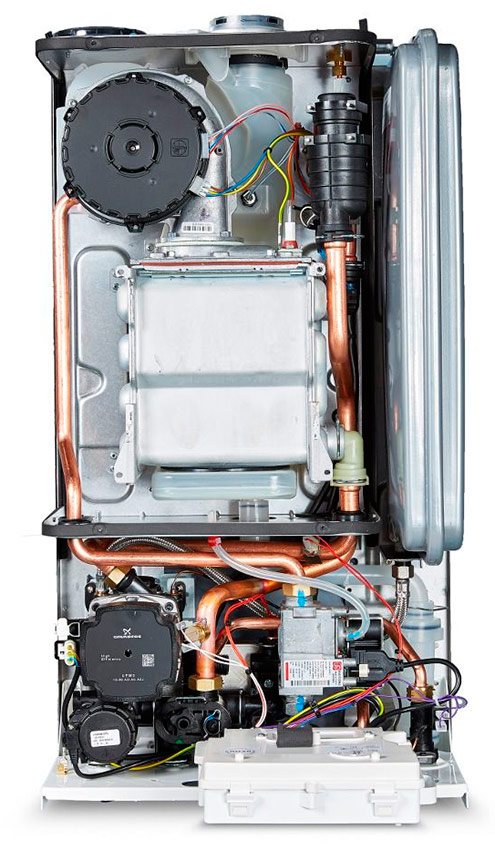

Wall mounted gas boiler with the cover removed.
Ease of installation
Which boiler, wall or floor standing, is easier to install? It would seem that this issue should not be of concern to the potential owners of the unit, but exclusively to the masters who will be engaged in the deployment of the heating system. However, do not forget that the buyer, that is, you, will have to pay for this, and the more laborious the work is, the larger the amount you will have to part with.
From the point of view of ease of installation, the wall-mounted boiler is the undisputed leader. In the case of a floor-standing unit, you have to equip an entire boiler room, because in addition to the boiler itself, you will have to install circulation pumps, an expansion tank and, perhaps, a boiler. The amount of work, as you might guess, differs very significantly, and the cost of work will also vary greatly.
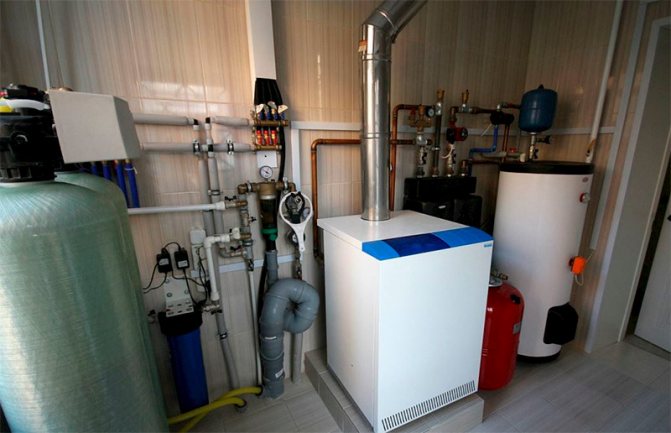

Life time
When buying any equipment, and even more expensive, we want it to serve, if not always, then at least as long as possible. This fully applies to gas boilers. What kind of boiler, wall or floor, will regularly heat our home for many years?
The service life of a gas boiler is primarily determined by the service life of its heat exchanger. There is no consensus at the moment about which material is the best heat exchanger - each has its own advantages and disadvantages.
In floor models, cast iron heat exchangers are usually installed. Cast iron is less susceptible to corrosion, but at the same time it is fragile, which means there is a risk of microcracking during transportation. In addition, it does not tolerate sudden changes in temperature.When using hard water as a heat carrier, the cast-iron heat exchanger is slowly destroyed as a result of the formation of scale and, as a consequence, local overheating of the material.
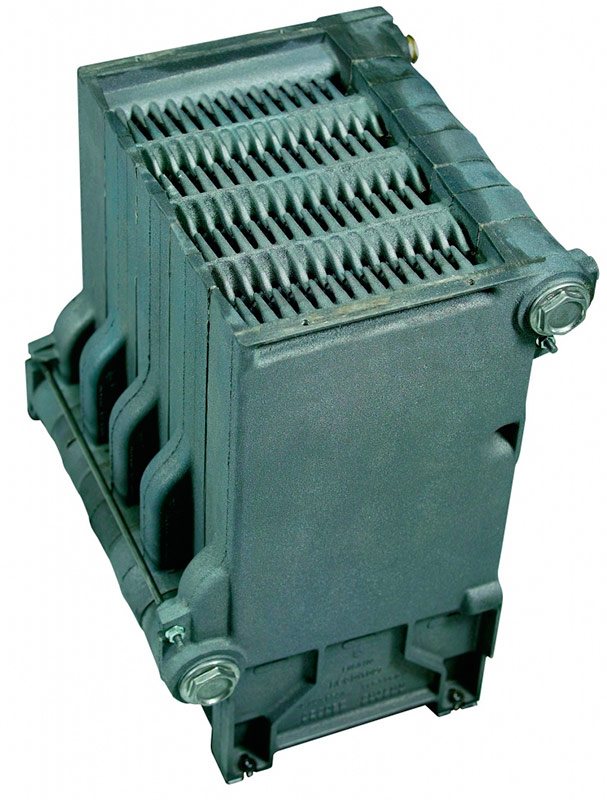

Cast iron heat exchanger.
For wall-mounted gas boilers, cast iron heat exchangers are not suitable, because they are too heavy. The most preferred material in this case is steel. The latter is not afraid of shocks during transportation, but strongly corrodes during operation, especially incorrectly.
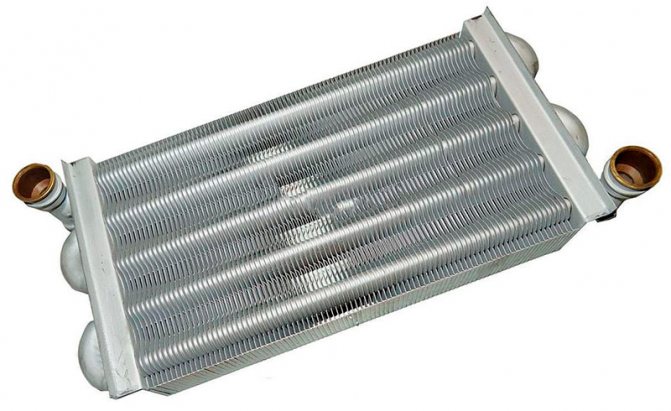

Steel heat exchanger for gas boiler.
So which heat exchanger is better? Since the boiler does not have to be transported very often, corrosion resistance can be considered the factor that has the greatest influence on the service life of a given structural element. From this it can be concluded that a longer period of normal operation can be expected from a floor-standing boiler with a cast iron heat exchanger.
It should not be forgotten that the service life of the boiler is also influenced by the wear and tear of other structural elements - circulation pumps, gas valve, electronics, etc. The quality of the unit depends on the quality of execution of each of its individual units. Practice shows that the average boiler from a well-known manufacturer, which is not indifferent to the reputation of the brand, will regularly serve you 15-20 years, no matter whether it is wall-mounted or floor-standing. Nobody knows what to expect from the “no name” unit.
Of course, in order for the heating equipment to work long enough, all the manufacturer's recommendations regarding operating conditions should be followed and the necessary maintenance should be carried out in a timely manner. The user is able to cope with many emerging problems on his own thanks to the self-diagnostics available in modern equipment.
What to choose
So, the question of which gas boiler is the most reliable, most likely, sounds incorrect in this case. Everything will depend on what goals the consumer sets for himself. Undoubtedly, wall-mounted models are best suited for organizing autonomous heating and hot water supply in apartments or small cottages. But the floor can only be used in private homes.
Of course, there are more successful models, there are less successful ones, besides, manufacturers use different materials in their products, hence the different quality, and, accordingly, the service life. Therefore, considering the rating of wall-mounted or floor-standing gas boilers, each consumer chooses the one that suits him in all respects. And here not only technical characteristics are taken into account, but also a cost indicator, and serviceability, and so on.
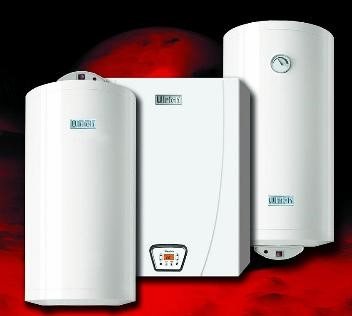

Variety of models
And the last thing. The question of how to choose a gas heating boiler worries many today. Therefore, advice: before purchasing a gas boiler, you need to consult a specialist who will sort through all the advantages and disadvantages of your chosen model. But keep in mind that sales managers can mislead you, their task is to sell their product. Therefore, consult an independent expert.
Coolant quality
The service life of a gas boiler and its output directly depend on the quality of the coolant. The use of water with increased hardness as a heat carrier leads to the formation of scale inside the heat exchanger. Scale, in turn, is the reason for a significant decrease in boiler efficiency and, as a result, in an increase in fuel consumption.
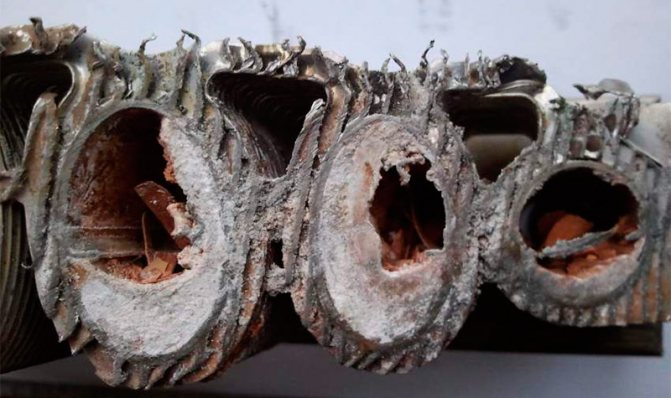

Gas boiler heat exchanger clogged with lime.
Both floor-standing and wall-mounted boilers "suffer" from scale to the same extent, only the level of complexity of solving the problem that has already arisen differs.The ease of disassembling and flushing the steel heat exchanger of the wall-mounted boiler allows you to quickly restore the operation of the heating equipment right at the installation site.
Flushing the cast-iron heat exchanger of a floor-standing boiler is difficult and, moreover, not always possible (many manufacturers insist that its disassembly and assembly be carried out exclusively in the factory). Most often, a faulty or scum-clogged cast-iron heat exchanger simply has to be replaced, and this part is by no means cheap.
It follows from this that the installation of a floor-standing boiler with a cast-iron heat exchanger presupposes that you have a chemical water treatment plant. This device is not cheap, but in this case it is extremely necessary.
Steel heat exchanger for gas boiler
So which heat exchanger is better? Since the boiler does not have to be transported very often, corrosion resistance can be considered the factor that has the greatest influence on the service life of a given structural element. From this it can be concluded that a longer period of normal operation can be expected from a floor-standing boiler with a cast iron heat exchanger.
It should not be forgotten that the service life of the boiler is also influenced by the wear and tear of other structural elements - circulation pumps, gas valve, electronics, etc. The quality of the unit depends on the quality of execution of each of its individual units. Practice shows that the average boiler from a well-known manufacturer, which is not indifferent to the reputation of the brand, will regularly serve you 15-20 years, no matter whether it is wall-mounted or floor-standing. Nobody knows what to expect from the “no name” unit.
Of course, in order for the heating equipment to work long enough, all the manufacturer's recommendations regarding operating conditions should be followed and the necessary maintenance should be carried out in a timely manner. The user is able to cope with many emerging problems on his own thanks to the self-diagnostics available in modern equipment. Coolant quality
The service life of a gas boiler and its output directly depend on the quality of the coolant. The use of water with increased hardness as a heat carrier leads to the formation of scale inside the heat exchanger. Scale, in turn, is the reason for a significant decrease in boiler efficiency and, as a result, in an increase in fuel consumption.
Both floor-standing and wall-mounted boilers "suffer" from scale to the same extent, only the level of complexity of solving the problem that has already arisen differs. The ease of disassembling and flushing the steel heat exchanger of the wall-mounted boiler allows you to quickly restore the operation of the heating equipment right at the installation site.
Flushing the cast-iron heat exchanger of a floor-standing boiler is difficult and, moreover, not always possible (many manufacturers insist that its disassembly and assembly be carried out exclusively in the factory). Most often, a faulty or scum-clogged cast-iron heat exchanger simply has to be replaced, and this part is by no means cheap.
It follows from this that the installation of a floor-standing boiler with a cast-iron heat exchanger presupposes that you have a chemical water treatment plant. This device is not cheap, but in this case it is extremely necessary.
Power modulation
Depending on the implemented method of regulating the flame intensity, all boilers are divided into boilers with a staged or modulating burner. One- and two-stage burners have one or two operating modes respectively (usually 100% and 70% of maximum). The power of modulating burners can be smoothly regulated in a fairly wide range, which allows fine tuning of the boiler operation.Modulating burners provide fuel savings and maintain the desired temperature with minimal deviations.
A significant number of floor-standing gas boilers are equipped with one- or two-stage burners. Most of the wall-mounted models have a large power modulation range (from 40 to 100%), due to which they work "softer" - they turn on and off much less often than boilers with step burners.
Energy independence
For some consumers, an important parameter of a gas boiler may be the dependence of its operation on electricity. The energy independence of heating equipment is relevant for those whose house or summer cottage is located at a considerable distance from large settlements, i.e. in those places where power outages or power surges are possible, leading to the failure of expensive automation.
The autonomy of a gas boiler can be achieved in two ways. The first is to simplify the boiler control system as much as possible. That is, it is necessary to use a unit in which there is no electronics at all. All the automation of such a boiler is mechanical. The heating system, which uses a similar boiler, operating without electricity, must be with natural circulation.
The second method is the use of an electric generator, which converts the heat obtained during the combustion of gas into electricity necessary for the operation of the boiler automation. This option is preferable for most users as it creates fewer restrictions.
It is possible to find non-volatile models only among floor-standing gas boilers, which for some buyers will be a weighty argument in favor of the latter.
Installation site requirements
Before choosing a floor-standing or wall-mounted gas boiler, you should decide on the location of its installation.
The wall-mounted boiler, due to its compactness, can be placed in almost any room. The main thing is that a number of requirements are fulfilled that guarantee the safety of its operation: a closed combustion chamber, connection to a coaxial chimney, forced removal of flue gases and air injection, which ensures the maintenance of the combustion process. Installing a boiler with an open combustion chamber in a kitchen with an exhaust hood is unacceptable, since in this case a so-called “draft flip” is possible, in which the smoke from the boiler will go not into the chimney, but into the room.
There are not so many options for placing a floor-standing gas boiler. Due to the size of the boiler itself, as well as all kinds of related equipment, we can only talk about a separate room - the boiler room. Despite the fact that the boiler room does not belong to living quarters, when installing a gas boiler, it is necessary to ensure the normal removal of fuel combustion products and the flow of air.
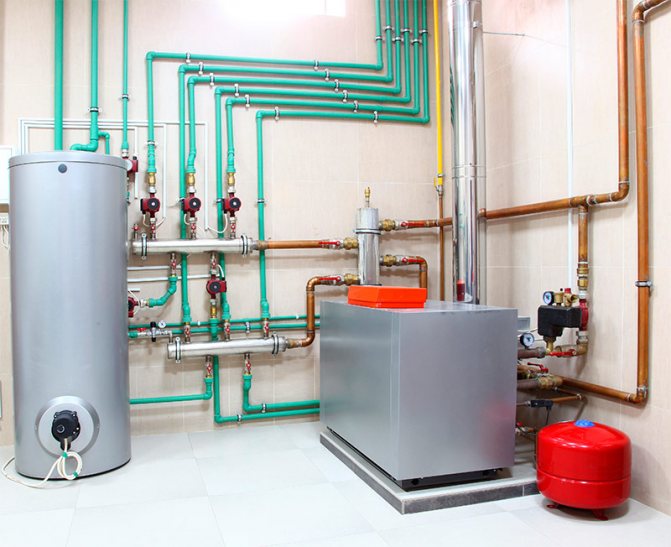

Choosing a place for the boiler
To install a gas boiler, first of all, you should prepare the room. Since the gas is explosive, the room in which the boiler will be located must comply with a number of standards and requirements. Let's take a look at some of them:
- In order to effectively remove the combustion products, a special channel is equipped in one of the walls.
- Ceilings must be at least 2.5 meters high.
- The room must have a natural light source.
- Place a ventilation grill at the bottom of the wall or door.
- Wall structures must have sufficient fire resistance.
- One of the main requirements for installation is the compliance of the chimney cross-section with the boiler output.
- The doorway must be at least 80 cm wide.
- The system must necessarily include a gas analyzer and an automatic valve, which, if necessary, must shut off further fuel supply.
- The layout should provide for easy access to the heating unit.
Connection diagram of a floor-standing double-circuit boiler
If the power of the boiler is no more than 60 kW, then it can be installed in any room, except living rooms. The best location for gas equipment is a bathroom.
It is forbidden to install double-circuit boilers in kitchens. Units with a capacity exceeding 150 kW may only be installed on the basement or ground floor. When installing less powerful structures, the floor does not matter.
Power
The power of wall-hung gas boilers, as a rule, varies from 10 to 40 kW. This is roughly enough to heat a dwelling with an area of 100 to 400 square meters. m. However, if part of the heat goes to heating water for domestic needs, then this power will be enough to heat only a relatively small house.
The capabilities of floor-standing gas boilers are significantly higher. The power of floor-standing models can reach 80-100 kW, and if it is equipped not with an atmospheric, but a forced-draft burner, then even more. If you need to heat a huge house or industrial facility, then a floor-standing boiler is exactly what you need.
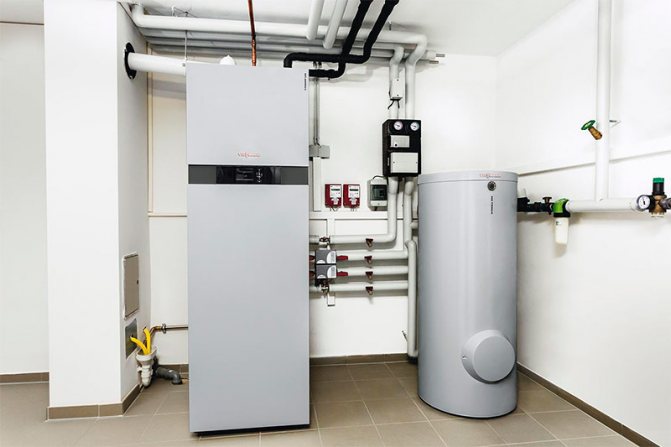

Cons of floor standing boilers
Important!!! Although floor-standing gas boilers for heating belong to the category of the safest high-tech units, it is still necessary to ensure control over their operation.
Sometimes even the smallest interruptions can disrupt the normal production cycle.
Despite the advantages, floor-standing gas equipment is also characterized by a number of disadvantages:
- Large dimensions and significant weight. For this reason, manufacturers are recommended to allocate a separate room for the installation of the unit, organizing a small furnace or boiler room. In addition, the fire safety requirements apply to the boiler room - an excellent ventilation system, free access and a properly assembled chimney.
- The obligatory presence of a chimney, which is responsible not only for the removal of combustion products and carbon monoxide gases, but also for the draft inside the combustion chamber.
- Complexity of installation. Manufacturers do not recommend installing floor models on their own, since without certain skills and tools it is impossible to make a high-quality installation of such a heavy product. For this reason, you will have to spend money on attracting installers.
- And, perhaps, the biggest problem when using floor-standing gas equipment is the decrease in pressure inside the gas pipeline in severe frosts. Unfortunately, floor units simply do not function in severe frost. Naturally, the fire will burn in the burner, but this will not be enough to heat the whole house.
Final comparison of wall-mounted and floor-standing gas boilers
| Wall hung gas boiler | Floor standing gas boiler | |||||||
| Dimensions (edit) | Less | More | ||||||
| Weight | Less | More | ||||||
| Equipment | The boiler is equipped with additional equipment | Additional equipment must be purchased separately | ||||||
| Ease of installation | Easier | More difficult | ||||||
| Life time | Steel heat exchangers are more susceptible to corrosion, which reduces the service life | Units with a cast iron heat exchanger can operate for a longer time | ||||||
| Coolant quality | The dependence on the quality of the coolant is high, but it is easier to flush the heat exchanger | The dependence on the quality of the coolant is average, but it is more difficult to flush the heat exchanger | ||||||
| Power modulation | More possibilities | Less opportunities | ||||||
| Energy independence | Fully volatile units | There are non-volatile units | ||||||
| Installation site requirements | Less | More | ||||||
| power, kWt | 10 — 40 | 80 — 100 | ||||||
| The cost | Below | Above | ||||||
If you notice an error, not a working video or a link, please select a piece of text and click Ctrl + Enter.
0
Recommendations for choosing a gas heating boiler
Considering various options for heating equipment, the buyer first of all looks at the price tag, and only then at the description of the parameters and characteristics. If your goal is to purchase the maximum inexpensive device, you should pay attention to wall structures. In this way, small dwellings can be heated. In this case, an electric boiler will be responsible for the DHW system. Some suspended models may have a coaxial chimney that runs directly through the wall. This makes it possible to save on the construction of a separate chimney through the roof and roof, as well as on the arrangement of the installation of the expansion tank.
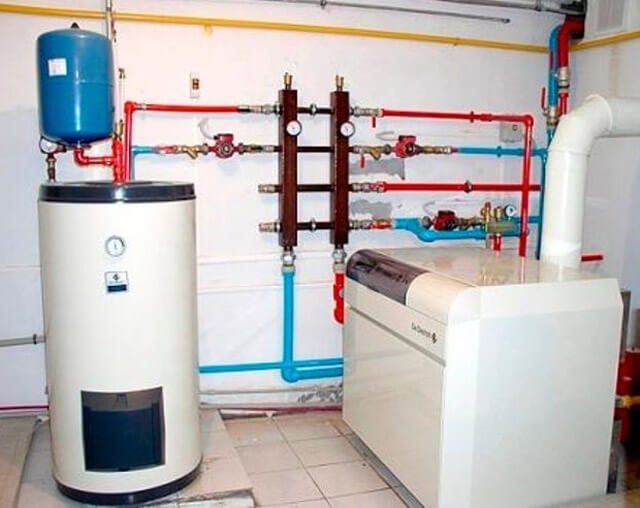

The second most important criterion that helps to determine which gas boiler is better than a floor-standing or mounted one is the level of gas consumption. Condensing boilers are especially good in this respect. Their operation requires almost 30% less fuel, which translates into more expensive cost and further maintenance. As a result, the achieved economic effect is interrogative here. Usually such devices are equipped with steel heat exchangers.
Equipment for country houses must necessarily have several inputs and outputs: this will make it possible to switch hot water supply or a system of underfloor heating during operation. Because the pressure level in the gas mains and the voltage in the electrical networks are not stable, it is very important that the gas boiler is equipped with reliable control and safety automation.
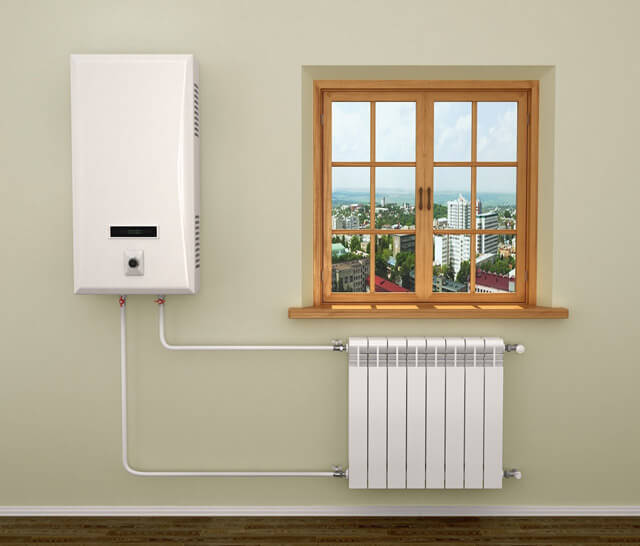

These are the following devices:
- Blocking thermostat. Responsible for stopping the gas supply when the water is heated to the desired temperature.
- Controllers and blockers. Stop the supply of gas and water in case of power surges or pressure surges in the gas pipe.
- Gas supply blocker. Reacts to the damping of the main burner.
- Traction sensor. Monitors the extraction power.
- Voltage stabilizer or uninterruptible power supply. These devices are completed with volatile heating equipment.
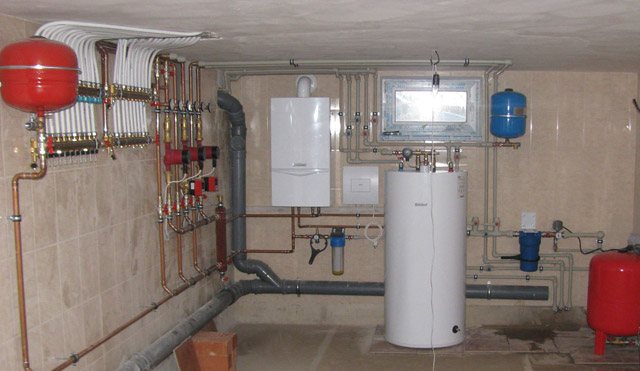

Getting the right gas boiler is just the beginning. Choosing gas heating, you should immediately prepare for numerous trips to various authorities in order to obtain the appropriate installation permits. Only specialists can carry out installation activities: otherwise, the permitting act will not be signed. Floor standing boilers can be installed in separate rooms, designed in accordance with all standards of the gas and fire service.


